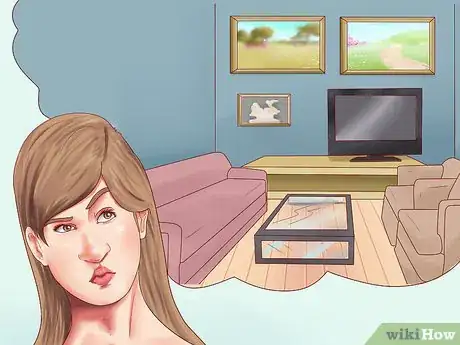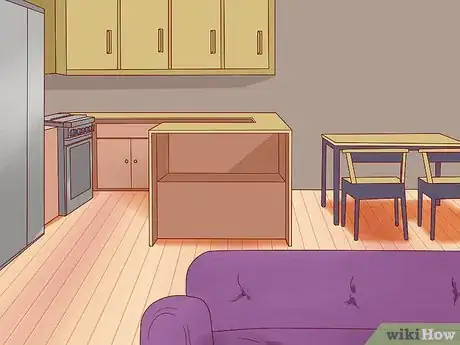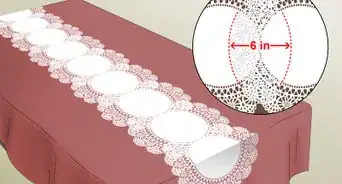This article was co-authored by Priscilla Bettencourt. Priscilla Bettencourt is an Home Stager, Interior Designer, and the Founder of Halcyon Home Staging + Design, a home staging business based in San Francisco, California. Halcyon specializes in expansive staging services geared to maximize a property's resale value and transform any home into an inviting environment for potential buyers. Halcyon has received the “Best of Houzz Service” Award in 2017, 2018, 2019, and 2020.
This article has been viewed 26,648 times.
You need to cross an ocean of tile to pour yourself a glass of water. The walk from the fireplace to the sofa requires two days of camping gear. Guests bring bullhorns so they can hear each other across your living room. It's time to put on your designer cap and divide these rooms into something livable.
Steps
Designing a Division
-
1Identify zones within the room. A large room can have several functions, such as cooking and eating, or watching television and entertaining guests. Figure out what the room is used for, or what you would like it to be used for, so you can divide it into separate spaces for each purpose.
-
2Bring furniture in from the edges. If the furniture is currently pushed back around the edges of the room, trying pulling it inward, creating a walkway around the room. This often looks more aesthetically pleasing, and can help you conceptualize the room as multiple sections, instead of one large space.Advertisement
-
3Try to divide a room into pleasing ratios. If you have a rectangular room that you want to divide, think about which divisions look best. A room, or a sub-section of a room, tends to be most pleasing when its width is between 1/2 and 2/3 of the length.[1] If that is not feasible, try to divide the room into squares. A space with equal proportions is usually better received than a space in which the width and length are highly uneven, or almost equal but noticeably "off."
-
4Consider existing aesthetic divisions. If ceiling beams are present, you could divide the room along the length of a beam for a more natural appearance. Permanent features on the wall, such as a set of French doors or a fireplace, can become the central focus of a sub-section after you divide the room.
-
5Think about how your furniture would look in a smaller space. If you have large living room furniture, it may look out of place once your living room has shrunk to make room for a dining space. If you don't want to replace your furniture, consider one of the less "permanent" dividers in the next section, so light and air still gives the impression of a larger room.
-
6Plan out your walkways. Provide three feet (0.9m) of space wherever people will be walking, or more if the house is used by energetic children, larger people, or people with walkers or wheelchairs. If your new division does not allow for easy access to each part of the room, you may need to remove one or more items of furniture, or replace them with smaller pieces.
Selecting a Divider
-
1Utilize area rugs to identify separate spaces.[2] This will help break up the space into different "rooms."
-
2Use a tall bookcase for functional division. A bookcase reaching above head height effectively divides the room while providing storage or decoration space. Many people use an open-backed bookcase for this purpose, in order to allow light through.[3]
-
3Consider curtains or hanging panels if you plan on changing décor regularly. Curtains hanging from the ceiling can be easily installed and removed, making them a good option if you want the option of changing the color or style of your divider. Hanging panels have similar benefits, and can be purchased in shorter lengths if you do not wish the rooms to be completely blocked off.
- You can install light ceiling-mounted curtains yourself, by mounting extra-light cable across the ceiling with hook screws.[4] You may want to consult an experienced handyman to find out which screws will work best for your wall and ceiling material.
-
4Try sliding doors or panels for a more solid division. These installations are made from solid materials, usually wood or semi-opaque glass, and can block sound and smell more effectively than other options. Nevertheless, they can still slide out of the way when you wish to open up the room.
- Sliding doors can be difficult to install without an existing opening. Hiring a professional is recommended unless you are experienced at home alterations.
-
5Use long, low furniture to divide the room without blocking vision. A large room doesn't always need barriers to feel divided. Place a long sofa with a low or nonexistent back across the center of the room to break the room up into sections while still allowing people to talk across it.[5] This is a great solution if you wish to host a large number of guests, but dislike the empty or bare feeling of the room large enough to host them all.
- Similarly, a kitchen counter or bar counter can divide a large room into a kitchen and dining area.
-
6Consider a screen or room divider that suits your style. A paneled room divider can be made of glass, fabric, wood, or other materials, and can be painted or decorated in any style. A transparent divider will let light through to keep the hint of a larger room, while an opaque one will create a more solid effect. Dividers require no special installation, and can easily be moved if you change your mind.
- Room dividers may not be appropriate if there are energetic pets or children in your home, as they can be knocked over.
Making a Large Room Cozier
-
1Create a focal point. A large space can look overwhelming if there is nothing to focus on. Arrange the seating and other furniture to face an object of attention, such as a television, fireplace, or large painting. If the furniture needs to be arranged inward, for instance toward the dining table, create a focal point with a chandelier or centerpiece.
- Use portable furniture to rearrange the space if you would like to use different focal points at different times. For instance, one or two light chairs can be added to the living room in front of the television when you want to encourage conversation.
-
2Use oversize furniture. If the room feels too large, even after dividing it, use furniture on a similar scale. A high ceiling can feel less imposing if there are high-backed chairs in the room to match. A coffee table could be replaced by a large ottoman to fill the space between seats more comfortably.
-
3Keep tall house plants in the room. If you enjoy gardening, pot a lemon tree, a fern, or another plant next to a corner or wall that looks empty. Tall plants are a good choice if you have a high ceiling, and add a natural appearance that can't easily be achieved with furniture alone.
-
4Hang wall art. Tapestries are much larger than paintings, and can be used to fill walls on a grand scale. However, even a collection of small paintings hung in groups can make the room feel cozier.
-
5Add smaller decorations to surfaces. Place artwork on countertops and tables to draw attention to the smaller scale. Even just one or two pieces can give people something to focus on close up, rather than feeling dwarfed by the scale of the room.
-
6Give the room a new coat of paint. If you're willing to put in the work, a redesign with deep, rich colors such as burgundy or dark brown can make a room feel cozier. This can also help divide a room visually, by drawing attention to a smaller area with windows or wainscoting accented in different colors.[6]
Expert Q&A
-
QuestionHow do you divide a large room without dividers?
 Priscilla BettencourtPriscilla Bettencourt is an Home Stager, Interior Designer, and the Founder of Halcyon Home Staging + Design, a home staging business based in San Francisco, California. Halcyon specializes in expansive staging services geared to maximize a property's resale value and transform any home into an inviting environment for potential buyers. Halcyon has received the “Best of Houzz Service” Award in 2017, 2018, 2019, and 2020.
Priscilla BettencourtPriscilla Bettencourt is an Home Stager, Interior Designer, and the Founder of Halcyon Home Staging + Design, a home staging business based in San Francisco, California. Halcyon specializes in expansive staging services geared to maximize a property's resale value and transform any home into an inviting environment for potential buyers. Halcyon has received the “Best of Houzz Service” Award in 2017, 2018, 2019, and 2020.
Home Stager & Interior Designer One easy way is to use area rugs to break up the space into separate "rooms."
One easy way is to use area rugs to break up the space into separate "rooms."
References
- ↑ http://chestofbooks.com/food/household/A-Manual-Of-Home-Making/Room-Shape-And-Proportion.html#.U_lkqUiVspM
- ↑ Priscilla Bettencourt. Home Stager & Interior Designer. Expert Interview. 10 July 2020.
- ↑ http://snyderhomesvt.com/5-clever-ways-to-divide-space/
- ↑ http://www.apartmenttherapy.com/how-to-hang-curtains-across-an-829
- ↑ http://www.houzz.com/ideabooks/7974302/list/13-Strategies-for-Making-a-Large-Room-Feel-Comfortable
- ↑ https://www.valuepaintingtenn.com/2014/01/14/living-large-cozy-up-your-cavernous-rooms/











































































